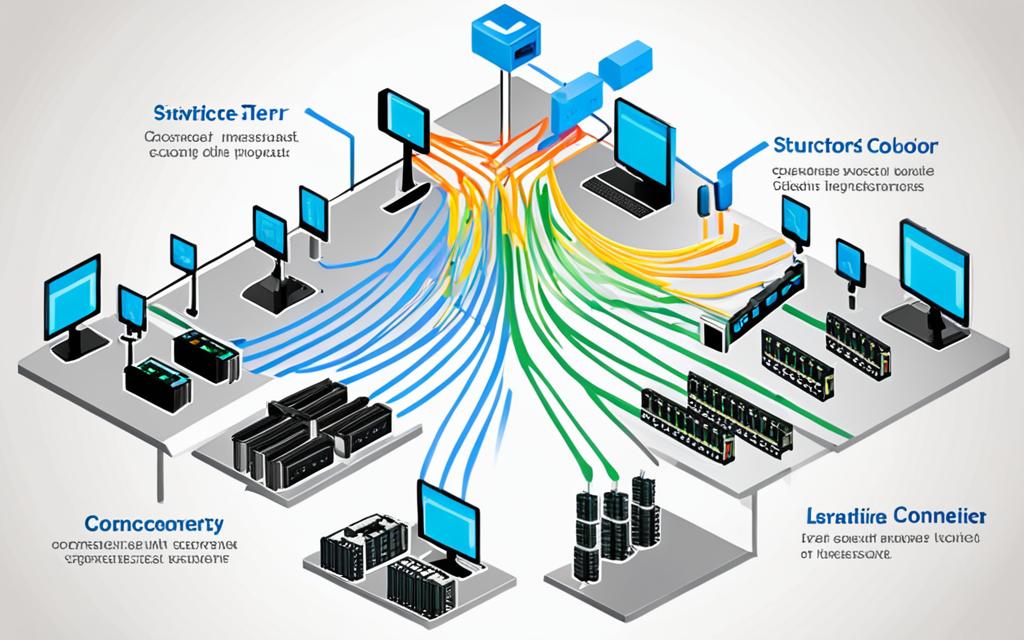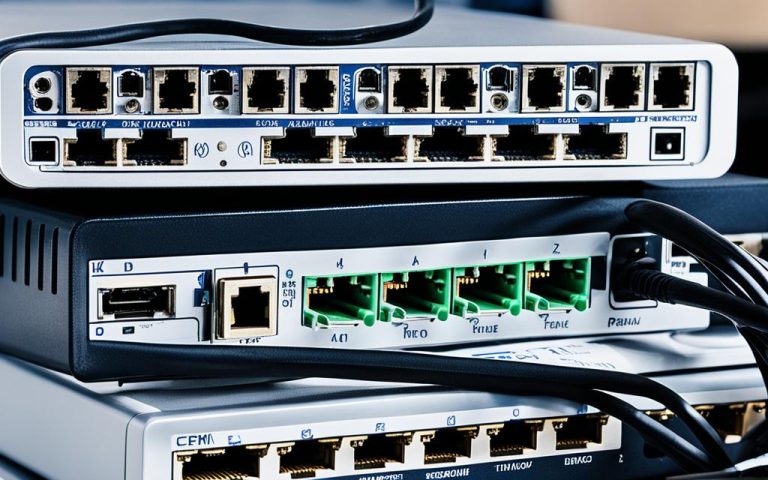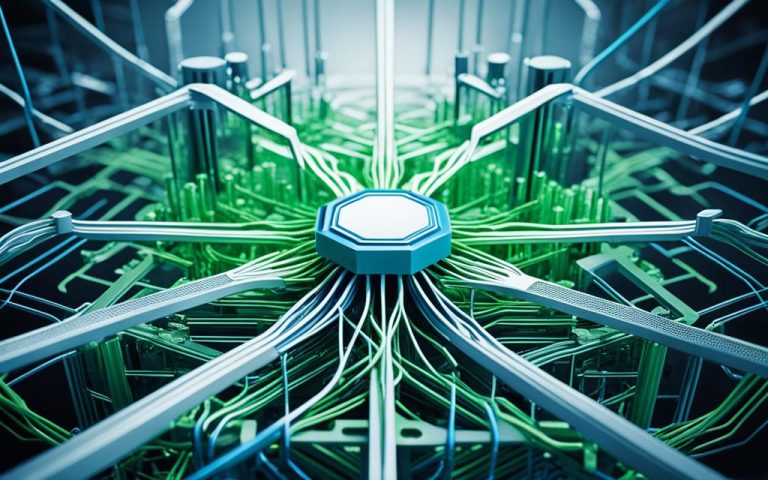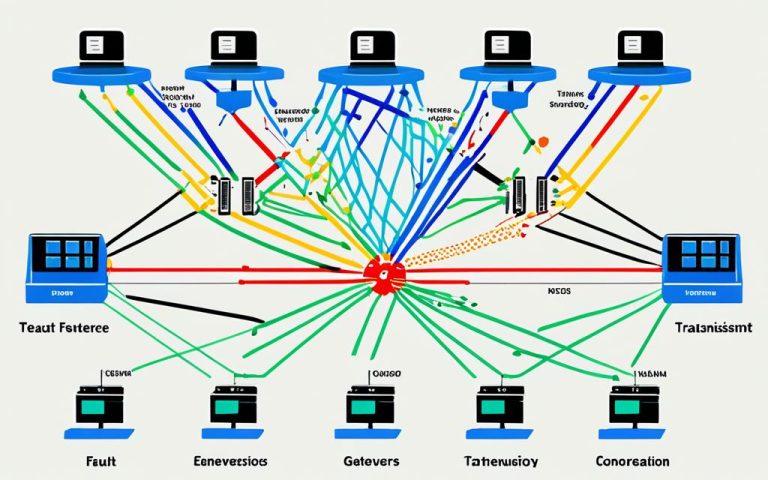A two-tier LAN network design has two main parts: the access layer and the distribution layer. All LANs connect to switches in the access layer. The distribution layer has multi-layer switches that link to each LAN switch1. This setup is not perfect because it can fail at one point1.
But, an ideal version of this design has two multi-layer switches in the distribution layer. This setup cuts down the risk of single-point failures1. On the other hand, big companies often use a three-tier architecture. This includes an extra layer called the core layer to manage traffic better2. This design is more reliable but also more complex and expensive2.
Key Takeaways:
- A two-tier LAN network design has an access layer and a distribution layer1.
- The access layer connects all LANs to switches, while the distribution layer has multi-layer switches1.
- An ideal two-tier setup uses two multi-layer switches in the distribution layer to prevent single-point failures1.
- A three-tier architecture, with an extra core layer, is more reliable but costs more and is more complex2.
Daisy-Chaining of Switches
Daisy-chaining switches means linking devices together to share interrupts. This method is not recommended in LAN networks. It makes the network vulnerable to failure if one link breaks. To keep the network stable and available, avoid this setup.
Instead, use strong and reliable network designs. This approach helps avoid single points of failure. It also boosts network performance and keeps it running smoothly.
There are many ways to set up a LAN network, each with its own pros and cons. For example, there are seven main types of network topologies: point to point, bus, ring, star, tree, mesh, and hybrid3. Each type has its own benefits and things to consider.
Point to point networks are fast and simple to set up. They offer high speed and are easy to maintain3. But, they’re not good for large networks and can’t handle many devices well3.
Bus networks are easy to expand and help isolate problems. They use cables efficiently and are good for adding devices3. But, finding faults can be hard, and a damaged cable can take down the whole network3.
Ring networks reduce data collisions and are fast for data transfer. They make finding faults easy3. But, adding or changing devices is tricky, and a single cable failure can disrupt the network3.
Star networks are easy to maintain and quickly spot issues. Adding new devices is simple3. But, they need more cables and can fail if the central hub goes down3.
Choosing the right network topology is key for a LAN network. By looking at the data from link 1, companies can pick the best setup for their needs3.
Two-Tier Architecture
Two-tier architecture is a way to organize LANs into two layers: the access layer and the distribution layer. LANs connect to switches in the access layer. The distribution layer has multi-layer switches that link to each LAN switch. This setup makes networks scalable and efficient, ensuring devices communicate smoothly and boosts network performance.
The access layer has switches that connect to devices in LANs. These switches manage network traffic at the edge. They make sure each LAN can communicate efficiently, ensuring data moves fast and reliably.
The distribution layer has multi-layer switches that connect to access layer switches. These switches gather traffic from access layer switches and link them to the router. This layer boosts network performance by routing traffic and managing data flow.
Two-tier architecture is simple and efficient. It separates the network into two layers, making it easier to manage. This setup also makes troubleshooting and maintenance quicker.
But, this design could have a single point of failure. If a switch in the distribution layer fails, it could break network connections for all LANs. To avoid this, using redundant components and high availability measures can keep the network strong and reduce downtime.
Overall, two-tier architecture is a popular choice for LANs. It offers scalability, efficiency, and easy management. By using switches and structuring the network well, organizations can create strong local area networks that meet their needs.
| Advantages | Disadvantages |
|---|---|
|
|
By following best practices for secure networks, like dividing the network and using firewalls, organizations can make their two-tier LANs more secure4.
Stay tuned for the next sections where we’ll look at other network designs and their benefits.
Ideal 2-Tier Architecture
To lower the risk of losing everything at once, the ideal 2-tier architecture was created. It’s also called the 2-Layered Collapsed Core Model. This setup uses two multi-layer switches in the distribution layer. This makes the network more reliable and affordable for small businesses5.
The distribution layer connects the access layer to the core layer. It makes sure data moves smoothly between devices and network resources. This layer spreads traffic across switches, boosting network speed and size5.
The access layer is at the bottom and links devices like computers and servers to the network. It lets users get to network services and resources. This design makes the network more available and reliable, reducing the effect of failures in the access layer6.
Adding redundancy at the distribution layer stops a single failure from taking down the whole network. If a switch fails, another one steps in without pause, keeping the network running. This setup makes the network more reliable and cuts down on downtime5. It also makes maintenance and upgrades easier, as one switch can be worked on without stopping the network6.
This architecture is a solid choice for small to medium networks. It has redundancy and boosts network speed while lowering the risk of losing everything at once. The distribution and access layers work together to keep the network running smoothly, supporting data transfer and connectivity needs65.
| Architecture | Network Size | Scalability | Redundancy |
|---|---|---|---|
| Ideal 2-Tier Architecture | Small to medium-sized | Limited scalability | Redundancy at distribution layer |
| Three-Tier Architecture | Large and complex | Scalable | Redundancy at distribution and core layers |
| Spine-Leaf Architecture | Data centers, cloud environments | Highly scalable | Redundancy at spine and leaf switches |
Three-Tier Architecture
Designing LAN networks often involves the three-tier architecture. It splits the network into three main layers: access, distribution, and core.
The access layer connects LANs to switches, acting as a bridge between devices and the network. The distribution layer has multi-layer switches that manage traffic and boost network capacity. These switches connect to LAN switches.
The core layer is the network’s backbone. It sends large amounts of data at high speeds. It connects distribution switches and handles traffic between them.
This architecture has many benefits. It boosts performance by working together efficiently. It’s also easy to maintain and scale, making it simple to add new devices. Plus, it’s reliable thanks to redundancy and load balancing.
But, this architecture is more complex and costly than the two-tier type. Big companies often choose it for its reliability78.
| Advantages of Three-Tier Architecture | Disadvantages of Three-Tier Architecture |
|---|---|
|
|
In complex networks with many devices, the three-tier architecture is useful for big companies. To improve bandwidth and redundancy, using MLAG (Multi-Chassis Link Aggregation Group) is an option8.
Spine-Leaf Architecture
The spine-leaf architecture changes how networks work, making them faster and more reliable. It’s a new way to build networks that helps them grow easily. This design is better than old three-tier networks for today’s data centers.
This architecture uses a simple two-layer setup with spine and leaf switches. It makes moving data fast and reliable. It cuts down on delays and makes networks work better9.
Unlike old networks, spine-leaf focuses on moving data between servers inside the data center. This makes it great for places where servers talk to each other a lot9. It helps data move quickly and efficiently, making the data center run smoother.
When designing spine-leaf networks, it’s important to keep an eye on the oversubscription rate. It should be under 3:1 to keep the network running well9. This rule helps the backbone switches handle all the data without getting clogged up.
The size and power of spine switches are key to how well the network can grow and handle data. This affects how big the leaf switches can be9.
Spine-leaf architecture works at both Layer 2 and Layer 3 of the OSI model. Using protocols like TRILL or SPB at Layer 2 makes the network more flexible and fast9.
Spine-leaf architecture has many benefits. It makes networks more reliable, faster, and easier to grow. It also cuts down on delays and saves money on network gear9.
But, spine-leaf design has its limits too. It needs special hardware, can’t support as many hosts, and requires a lot of cables. Scaling it up can also be tricky9.
Spine-Leaf Architecture in Visual Representation
The image shows what spine-leaf architecture looks like. It has spine switches at the core and leaf switches at the edge. This setup makes sure data moves quickly and reliably through the network.
Benefits of Two-Tier LAN Network Design
The two-tier LAN network design is great for businesses that need a strong and growing network. It uses a distribution layer and an access layer to make the network reliable, scalable, and fast. This setup can handle more data as your business grows.
This design makes sure your network is always connected and fast. It meets high-speed needs with the IEEE’s 802.3bz standard, which supports up to 5 Gbps Ethernet10. Cisco’s technology also boosts speeds, making sure devices connect smoothly10.
It’s also easy to grow this network as your business does. You can add more capacity, like 10 Gbps Ethernet, to keep up with your needs10. This means you can add more sites, devices, and users without trouble.
Performance is a big plus of this design. The distribution layer helps manage traffic and keep things secure11. Plus, features like Virtualized StackWise Access make the network run even better10.
Having a reliable network is key for businesses. Downtime can cost a lot in productivity and money. The 2-tier design spreads out network functions to reduce failures and keep things running smoothly10. But, it might not be as resilient as a three-tier model12.
In summary, a two-tier LAN network design is great for reliability, growth, and speed. It uses layers to make a strong network that meets your business needs. Whether it’s the 2-tier or spine-leaf design, it ensures your network works well, performs well, and has less downtime.
“A two-tier LAN network design provides reliable, scalable, and high-performance network infrastructure.”
Cisco’s Campus LAN and WLANDesignGeeksforGeeks.org: Hierarchical Network DesignEIRE Systems: Collapsed Core Network Design
Considerations for LAN Network Design
When designing a LAN network, think about the cost, complexity, and size of the enterprise. A good network design matches these factors to boost efficiency and meet business needs.
Cost: The cost of a LAN network depends on the architecture and how big the enterprise is. Small businesses might choose a two-tier architecture to save money. This design combines layers, cutting down on hardware and cables.
Complexity: How complex a network is affects its setup and management. Small businesses might prefer simple designs if they don’t have many IT resources. But big companies might go for a three-tier architecture for better reliability and growth.
Size of the enterprise: The enterprise’s size is key in picking the right network design. Small to medium businesses often do well with a two-tier setup. But big companies need a three-tier architecture for more users and locations.
Thinking about cost, complexity, and size helps designers make a LAN network that fits the company’s needs. This leads to better performance and efficiency across the enterprise. It’s vital to look at these factors when planning a LAN network to make it work best.
| Considerations | Two-Tier Architecture | Three-Tier Architecture |
|---|---|---|
| Cost | Lower hardware and cabling costs | Higher initial investment |
| Complexity | Relatively simpler design | Higher level of complexity |
| Size of the enterprise | Smaller-scale networks | Scalable for larger enterprises |
When thinking about LAN network design, look at what your enterprise really needs. Analyzing the cost, complexity, and size will help you make the right choice. This ensures your network supports your goals and objectives.
References
- 13 Statistical data from link 1.
Network Design Best Practices
To make a strong and efficient network, it’s key to follow the best practices in network design. These practices help improve network performance, reliability, and ability to grow. Let’s look at some important aspects of network design that are considered best practices.
Redundancy for High Availability
One key practice is using redundancy. This means having extra parts to lessen the chance of a single failure point. By having backup power supplies, multiple network links, and extra devices, networks can keep running smoothly even if something fails. This keeps important business operations going without interruption14.
Network Security
Security is very important in network design today. Companies need to use strong security steps to keep data safe from unauthorized access and cyber threats. This includes setting up firewalls, controlling access, and using encryption to protect sensitive info. Regular checks and updates are also crucial to keep the network secure14.
Scalability for Future Growth
A good network design should be able to grow with the business. Scalable networks let companies expand without big problems or high costs. By planning for bandwidth needs and using modular designs, networks can grow smoothly as the business changes14.
Network Monitoring and Maintenance
Keeping an eye on the network and doing regular maintenance is key. Best practices include using tools to watch network traffic and device health. This helps IT teams spot and fix issues early. Regular updates and backups keep the network running well14.
Implementing Industry Standards and Frameworks
Using industry standards and frameworks in network design makes things more compatible and well-planned. Following standards like the OSI model and using frameworks like Cisco’s PPDIOO model helps in a structured approach. These frameworks make designing networks easier, improve performance, and ensure reliability14.
Following network design best practices helps build networks that are strong, secure, and can grow. Using redundancy, strong security, and scalable designs, and following industry standards are key. Regular checks and maintenance keep the network running well. These practices are the foundation for a network that supports the company’s growth and success14.
For more info on network design best practices, check out these resources:
– Learn more about network design best practices from this informative blog post onAuvik’s website14.
– Cisco’sCampus Wired LAN Design Guideis a great resource for insights on best practices and Cisco validated designs15.
– For details on different network architectures, including 2-tier and 3-tier designs, see this article onGeeksforGeeks7.
Implementing a Two-Tier LAN Network Design
Let’s dive into how to apply network design best practices with a two-tier LAN network design. This design is simple, scalable, and cost-effective for medium-sized companies.
In a two-tier LAN, the network has two main layers: access and distribution. The access layer connects devices like PCs and printers. The distribution layer manages traffic and security.
To avoid single failure points, it’s important not to chain switches together. Instead, use the 2-Layered Collapsed Core Model with two multi-layer switches. This setup ensures the network stays up and running7.
Another design option is the three-tier architecture. It adds a core layer for better traffic handling and reliability. This is more complex and costly, but suits large organizations needing top reliability7.
Choosing the right hardware and software is crucial for a two-tier LAN. Cisco offers various options like the 6807-XL and 6500-E for different network layers. These cater to specific needs and performance levels15.
“Implementing network design best practices such as redundancy, security, scalability, and adhering to industry standards like Cisco’s PPDIOO model can set the foundation for a reliable and efficient network infrastructure.”
Adopting network design best practices is vital for modern business networks. By using redundancy, focusing on security, ensuring scalability, and following standards, companies can build networks that offer high availability and performance. These practices, along with regular checks and maintenance, are key to a strong and resilient network design14.
Implementing a Two-Tier LAN Network Design
To set up a two-tier LAN network, planning is key. You need to think about the network’s layout and what devices like switches and routers you’ll need. It’s important to place these devices right and connect them correctly. Good planning makes sure the network fits the company’s needs7.
After planning, it’s time to configure the network. This means setting up switches and routers as per the plan. You’ll need to create VLANs, assign IP addresses, and set up security. Getting this right is crucial for a secure and working network7.
Testing the network is the next step. This checks if everything works well, moves data fast, and stays stable. Finding and fixing any problems early helps make the network better. It ensures the network does what it’s supposed to do7.
It’s important to follow the best practices while setting up the network. This means managing cables well, keeping things safe, and labeling equipment. Doing this makes it easier to fix issues and expand the network later7.
Benefits of Implementing a Two-Tier LAN Network Design
A two-tier LAN network has many advantages. It’s more scalable and flexible than older designs16. It also makes upgrading easier without affecting the whole network16.
This design cuts down on the number of connections needed, making it simpler to manage16. It performs better and is more reliable, thanks to fewer points of failure716.
Using redundant switches in the middle layer makes the network even more reliable7. This is great for companies that need their network to always be available7.
Overall, a two-tier LAN network is good for today and tomorrow. With careful planning and testing, companies can get a network that grows with their needs7.
| Benefits of Implementing a Two-Tier LAN Network Design |
|---|
| Improved scalability and flexibility compared to traditional three-tier designs |
| Easier upgrades and modifications without impacting the entire network |
| Simplified network management and reduced complexity |
| Improved fault tolerance and reduced risk of single point of failure |
| Enhanced reliability through redundant multi-layer switches |
| Support for future growth and advancements in network technology |
Setting up a two-tier LAN network is a detailed process. It involves planning, configuring, and testing. By following best practices, companies can build a network that’s scalable, reliable, and easy to manage716.
Challenges in LAN Network Design
LAN network design has its own set of challenges that experts must tackle for reliable and efficient connections. Building and keeping LAN networks up and running requires a lot of knowledge and attention to detail.
One big challenge is dealing with the complexity of combining different network parts and tech. With so many devices, protocols, and services, making sure everything works together smoothly is key. Network pros must make sure all these elements fit well to keep data flowing and communication clear.
Fixing network problems is a big part of LAN design that’s tough. Quickly finding and solving issues is vital to keep things running without interruptions. Network pros need great troubleshooting skills to handle these problems well.
Adding new tech and making sure devices and platforms talk to each other smoothly is hard. Companies must blend old systems with new ones, like cloud services and IoT devices, while keeping things secure and fast.
LAN networks must grow and change with the company. They need to handle more devices and users without slowing down or losing security. This means careful planning and action to keep networks running well.
Getting different VLANs to work together also makes LAN design tricky. Network pros must think about the network’s size, security needs, and how different VLANs will talk to each other. Choosing between Layer 2 and Layer 3 switches17 affects the LAN’s design and how it works.
In short, LAN network design has its challenges. From handling complexity to troubleshooting and adding new tech, network pros must be skilled. Keeping up with trends and working with experts is key to beating these challenges and designing networks that fit an organization’s needs.
Conclusion
A two-tier LAN network design brings many benefits to organizations. It has an access layer and a core layer, making it scalable, cost-effective, and easy to manage18. This setup is great for small businesses, offering a reliable way to share information and data. It also makes upkeep simpler, saving time and money18.
Before picking a LAN design, it’s important to think about what your business needs. Consider things like cost, how complex it should be, and if it can grow with your business18. This careful planning helps you choose the right network design for your company.
For a successful two-tier LAN setup, follow best practices and get help from experts18. This approach ensures your network is well-organized and ready for growth. It helps your business stay productive and competitive.
FAQ
What is a two-tier LAN network design?
A two-tier LAN network design has two main parts: the access layer and the distribution layer.
What are the components of a two-tier LAN network design?
It includes LAN switches for the access layer and multi-layer switches for the distribution layer.
What are the benefits of a two-tier LAN network design?
This design offers a dependable and expandable network setup. It boosts network speed and makes managing traffic easier.
Why is daisy-chaining of switches not recommended in a LAN network design?
Daisy-chaining switches can lead to a single point of failure. If one switch fails, the whole network can be affected.
How does a two-tier architecture differ from daisy-chaining of switches?
In a two-tier setup, LANs connect to switches in the access layer. The distribution layer has multi-layer switches for better performance and growth.
What is the ideal 2-tier architecture?
The ideal 2-tier setup, also known as the 2-Layered Collapsed Core Model, uses two multi-layer switches in the distribution layer. This reduces the risk of single-point failures.
What is a three-tier architecture?
A three-tier architecture has three layers: access, distribution, and core. It offers high reliability and scalability but is more complex and costly.
What is the spine-leaf architecture?
The spine-leaf architecture combines the core and distribution layers into one. It boosts performance, network uptime, and scalability.
What are the benefits of a two-tier LAN network design?
This design ensures a dependable and scalable network setup. It enhances network speed, reliability, and reduces downtime.
What considerations should be taken into account when designing a LAN network?
When designing a LAN network, consider the cost, design complexity, and enterprise size.
What are some best practices for network design?
Good network design practices include adding redundancy, ensuring security, planning for scalability, and regular monitoring and maintenance.
How do you implement a two-tier LAN network design?
To implement a two-tier LAN design, plan the network layout, decide on components, configure devices, and test thoroughly.
What challenges can arise in LAN network design?
LAN network design can face challenges like complexity in integrating components, troubleshooting, and managing network complexity.
Source Links
- https://www.ciscopress.com/articles/article.asp?p=2698000 – Network Design Models > “Do I Know This Already?” Quiz
- https://www.auvik.com/franklyit/blog/hierarchical-network-design/ – What is Hierarchical Network Design?
- https://www.spiceworks.com/tech/networking/articles/what-is-network-topology/ – Network Topology Diagrams and Selection Best Practices for 2022
- https://www.splunk.com/en_us/blog/learn/network-architecture.html – What Is Network Architecture? | Splunk
- https://ipcisco.com/lesson/network-topology-architectures/ – Network Topology Architectures ⋆ IpCisco
- https://www.linkedin.com/pulse/understanding-network-topology-architectures-two-tier-kefa-otengo – Understanding Network Topology Architectures: Two-tier, Three-tier, Spine-leaf, and SOHO
- https://www.geeksforgeeks.org/2-tier-and-3-tier-architecture-in-networking/ – 2 – Tier And 3 – Tier Architecture in Networking – GeeksforGeeks
- https://www.qsfptek.com/qt-news/what-is-three-tier-architecture-in-switch-networking.html – What is Three Tier Architecture in Switch Networking?
- https://www.techtarget.com/searchdatacenter/definition/Leaf-spine – What Is Spine-Leaf Architecture?
- https://www.cisco.com/c/en/us/td/docs/solutions/CVD/Campus/cisco-campus-lan-wlan-design-guide.html – {sectionTitle} – Campus LAN and Wireless LAN Solution Design Guide
- https://www.geeksforgeeks.org/hierarchical-network-design/ – Hierarchical Network Design – GeeksforGeeks
- https://www.eiresystems.com/what-is-a-collapsed-core-network/ – What Is A Collapsed Core In A Network Design? | EIRE Systems
- https://www.cisco.com/c/dam/en/us/td/docs/solutions/Enterprise/Education/CCVE/ccve_sba_LAN_design.pdf – PDF
- https://www.auvik.com/franklyit/blog/network-design-best-practices/ – Network Design and Best Practices
- https://www.cisco.com/c/dam/en/us/td/docs/solutions/CVD/Aug2014/CVD-CampusWiredLANDesignGuide-AUG14.pdf – Campus Wired LAN Technology Design Guide – August 2014
- https://www.computernetworkingnotes.com/ccna-study-guide/access-distribution-and-core-layers-explained.html – Access, Distribution, and Core Layers Explained
- https://www.auvik.com/franklyit/blog/layer-3-switches-layer-2/ – Layer 2 vs Layer 3 Network Switches: What’s the Difference?
- https://www.uninets.com/blog/types-of-network-topology – What is Network Topology? Types and Uses



















